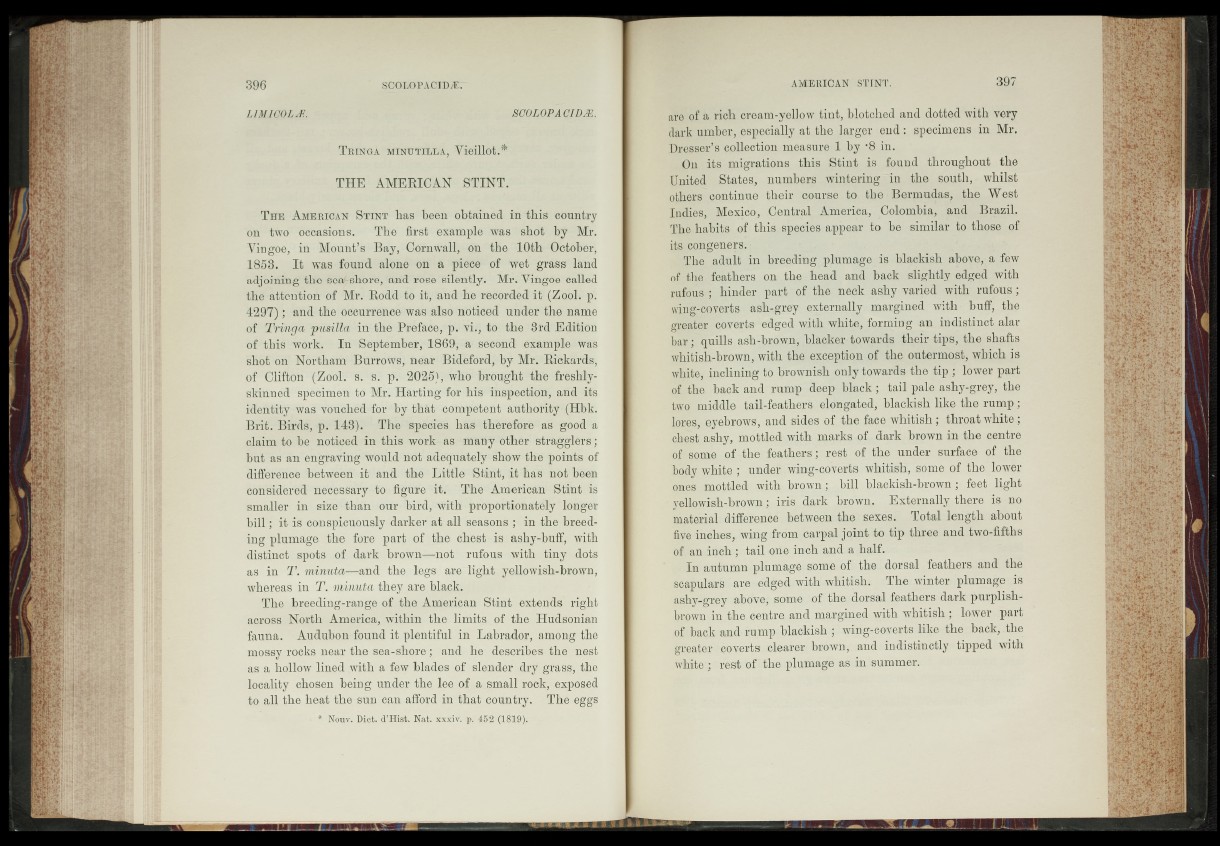
LIMICOLJi. 8C0L0PA CIDJK.
Tringa minutilla, Vieillot.*
THE AMERieiN STINT.
The American Stint has been obtained in "this country
’fen two 'Occasions. The first example was shot by Mr.
Yingoe, in Mount’s Bay, Cornwall, on the 10th October,
1858. It was found alone on a piece of Wet grass'land
adjoining the seafshore,‘aOd'rose silently. Mm-Yingoe'called
the attention of Mr. Redd to it-, and he recorded- it! (-Zool. p1.
4297) ; and the occurrence’ Was also noticed- u-ndef-the’ name
of Trmgcb piosilla in the Preface,'p.1 vi., to the"-3rd Edition
of this work. In September, 18'69V-u; second examfle.-was
shot on Northam Burrows, near dBldeforfe-by Mr/RickSrds,
of1 Clifton "(Zo’olv's. si1 p.- 2025), who brought the freshly-
skinned' specimen- to Mr. Harting-'for his’ inspeclabm an|fdt’s
identity was voucfedddbr ’by that authotky^^Hb k.
BiSiMBirds, p. 143)?-’ ■IPfe-specieS' k»S'thfei?efore-'as’>’g©od' a
claim* to be noticed in this work-aS ^'anyfefhen stragglers;
but'as an ehfpavirig would nfefr adequately show:the'’-points of
difference between iti:and the Li4€e^Ht$rft,- itdaas nfet'been
considered necessary -toH figure ’;rt& ■ The American- Stint fts
smaller in si^cHhan.' our bird, with-propoi^bhatei^ d o ^ e r
bilff- it is conspicuously darker at .all7sea|^yip: i& breed*
lihg plumage the fore part-* of the chest- is ashy-buff, j$j|h
distinct -spots of, dark brown|Bfeot Mrufous- with. tiny^dffitk
as in T\ miwwta—and the legs, are li^-t^yellowish-brown,
whereas in T. theware black.
The breeding-range of the, American S|iht,-e^t.ends right
across .North .America, within the ]imitst 0fpthe;*Hudsonian
fauna. ’ Audubon- found ‘xt^pMhtiful in Labrador, among tbe
mossy rocks near the ~sea-shore; - and he descnbps^thdvfeest
as a hallow lined with a few blades of slepder^lry grass, the
-locality chosen feeing pniter' the leds§La .small rocky exposed
fo all the heat thelsun can afford in that country, Thesgggs
■ * NouVi- Dict‘.'#!ffi44 Nat. p 452
are of k rich cream-yefeowjtint, blotefeed and dotted with very
dark umber, especially at tfee -larger end: specimens in Mr.
Dresser’s .collection measure|l|by ’8 in.
On.yijjs migrations this §5 tint is . found throughout the
United States, numbers wintering ~in the sq^ife,* whilst
others"continue their -cpursc to-%e» Bermudas, the West
Indies, Mexico; ,Qpntral America, Colombia, , and
The habits of. this-species appear to be similar to thQse of
r^ppngeners. |
Ajfee radu|t .in breeding plumage -'is-blackish aboye,- a^few
of thg, .£feat|ers,;op,the head and back slightly edged witfe
rufous ; hinder, part of tHe;.fneck ashy varied with rufous;
wing-mv.er.ts ash-grey externally margined; with buff, the
greater imverts'cdged white, fpfpiing an indi^^cL|^ar
bar;~\uills ashïbro.wn, fela&feejt towards their tips, the shafts
wfeitish-bf-oym, with tha exception of the outermost, whiefe js
white, inclining tfe feTOwniSh^ly-towarfls the tip.; lower part
dLihe, back and' rump" deep- black ; tail-palftfesfey^grey, tfee
two middle tail-feathers elon^^d^^fela^k^like the rump;
leres$eyobrows, and sidespf.-the face whitish; throatx\hite
chest asfey, mottled.,with markoof, dark brpwn in the centre
of4|ome ojy.the? feajfegrs ;* ,res|, of the under surface of tfee
body white.; undeEiwingioavepts | whitish,Spbme of "the lower
ones femo,ttlcd with brown; .bill blackisfe-ferown ; -/ee^L light
; iris dark fer.owfe^ Exterpallw^^e i§,po
material. difference between ,the| sexes. Total: length .about
jjaffia inches,, wing from^earpal joint -to jap-three and two-fifths
e-feandheh; tail one inchrandr^ih^ffi^
InïpaÊumn plumage, sfenremfi-the., dorsal feathprsuand the
scapulars are tseplg od; * with- whitish? The winter, .plumage; is
ashylgrey abd®©;1 s orne, serf itheyd or sal feathers .dark purplish«
indhe.^entre ,and mar gilded with, whitish ;> lower part
pSfaek and rump blackish ; wings coverts iikedhe backjJthe
gi^atpïi|ê©vefts^®lêareypb.EÓwn, iand;.indistinc%tippedrwith
Whitey-; rest- ©fLthëtplumage as in summer.